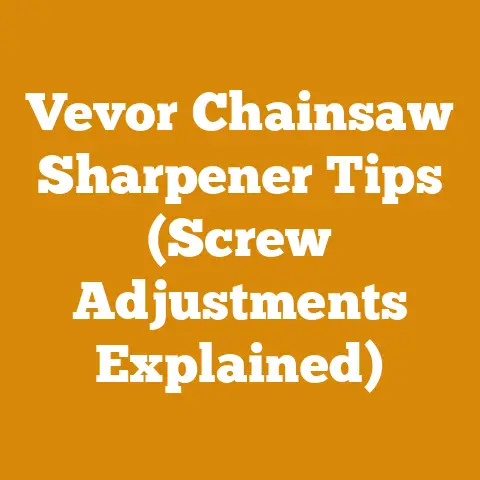Husqvarna 128LD Won’t Start (5 Expert Fixes for Trimmer Troubles)
Have you ever yanked on the starter cord of your Husqvarna 128LD trimmer, expecting it to roar to life, only to be met with… silence? Or worse, a pathetic sputter that dies before it even gets going? I know I have. There’s nothing more frustrating than a stubborn tool when you’re trying to tame the wilderness around your property. That’s why I’ve put together this guide: to help you troubleshoot and fix your Husqvarna 128LD trimmer when it refuses to start.
I’ve spent years wrestling with chainsaws, splitting firewood, and generally wrangling wood into submission. I’ve learned that even the most reliable tools can throw a wrench in your plans. The Husqvarna 128LD is a popular trimmer for a reason – it’s generally dependable. But like any piece of machinery, it can have its off days.
In this article, I’ll share five expert fixes that have worked for me and countless others in the field. We’ll dive deep into the potential culprits behind your trimmer’s refusal to start, from fuel issues to spark problems, and I’ll walk you through each solution step-by-step.
Husqvarna 128LD Won’t Start: 5 Expert Fixes for Trimmer Troubles
Let’s get your trimmer back in action.
1. Fuel System Check: Is Your Trimmer Starving?
One of the most common reasons a Husqvarna 128LD won’t start is a problem with the fuel system. Think of it like this: your trimmer needs fuel like you need food. If it’s not getting the right fuel, or enough of it, it simply won’t run.
The Problem:
Old, stale fuel is the number one offender. Gasoline degrades over time, especially when mixed with oil. This creates varnish and gum deposits that can clog the carburetor and fuel lines, preventing fuel from reaching the engine. Also, incorrect fuel mixture is a common mistake. The Husqvarna 128LD requires a specific fuel-to-oil ratio (usually 50:1), and using the wrong mixture can lead to engine problems.
My Experience:
I once spent an entire afternoon trying to start a stubborn chainsaw, only to realize I had accidentally grabbed a can of premix that was several months old. The fuel looked fine, but it was so degraded that it wouldn’t ignite properly. Lesson learned: always label your fuel cans with the date!
The Fix:
Here’s how to diagnose and address fuel-related issues:
- Step 1: Drain the Old Fuel: Carefully drain the fuel tank into an approved container. Dispose of the old fuel properly. Never pour it down the drain or onto the ground.
- Step 2: Inspect the Fuel Filter: The fuel filter is located inside the fuel tank, attached to the end of the fuel line. Use a hooked wire (like a straightened coat hanger) to carefully pull the filter out of the tank. Examine it for clogs or debris. If it’s dirty, replace it with a new one. Fuel filters are inexpensive and should be replaced regularly (at least once a year).
- Step 3: Check the Fuel Lines: Inspect the fuel lines for cracks, leaks, or kinks. Over time, fuel lines can become brittle and deteriorate. If you find any damage, replace the fuel lines.
- Step 4: Clean or Rebuild the Carburetor: The carburetor is responsible for mixing fuel and air in the correct proportions. If it’s clogged, it won’t function properly. You can try cleaning the carburetor with carburetor cleaner. Remove the air filter and spray the cleaner directly into the carburetor intake while pulling the starter cord. If that doesn’t work, you may need to remove and disassemble the carburetor for a more thorough cleaning. Carburetor rebuild kits are available for the Husqvarna 128LD, and they include all the necessary gaskets and diaphragms. If you’re not comfortable disassembling the carburetor yourself, you can take it to a qualified repair shop.
- Step 5: Use Fresh Fuel and Correct Mixture: Mix fresh gasoline with the correct amount of two-stroke oil according to the manufacturer’s instructions (usually 50:1). Use a high-quality two-stroke oil specifically designed for air-cooled engines.
Data Point:
A study by the Outdoor Power Equipment Institute (OPEI) found that over 70% of small engine problems are related to fuel issues. Using fresh fuel and following proper mixing procedures can significantly extend the life of your trimmer.
Actionable Takeaway:
Make it a habit to use fresh fuel and always mix it correctly. Label your fuel cans with the date, and discard any fuel that’s more than a month old.
2. Spark Plug Inspection: Is There a Spark?
If your trimmer has fuel but still won’t start, the next thing to check is the spark plug. The spark plug is responsible for igniting the fuel-air mixture in the engine, and without a good spark, your trimmer won’t run.
The Problem:
A fouled spark plug is a common issue. Carbon deposits, oil, or fuel can build up on the spark plug electrode, preventing it from producing a strong spark. A damaged spark plug can also cause starting problems. Cracks in the ceramic insulator or a worn electrode can weaken the spark.
My Experience:
I once spent hours trying to start a chainsaw in the middle of a logging job. I checked the fuel, the carburetor, and everything else I could think of. Finally, in desperation, I pulled the spark plug, and it was completely black with carbon buildup. A quick cleaning with a wire brush, and the saw fired right up.
The Fix:
Here’s how to inspect and address spark plug issues:
- Step 1: Locate the Spark Plug: The spark plug is located on the side of the engine, usually under a rubber boot.
- Step 2: Remove the Spark Plug: Carefully pull off the spark plug boot. Use a spark plug wrench to loosen and remove the spark plug.
- Step 3: Inspect the Spark Plug: Examine the spark plug for signs of fouling, damage, or wear. A healthy spark plug should have a clean, light brown color. If it’s black, oily, or cracked, it needs to be cleaned or replaced.
- Step 4: Clean or Replace the Spark Plug: If the spark plug is fouled but otherwise in good condition, you can try cleaning it with a wire brush or spark plug cleaner. If it’s damaged or worn, replace it with a new spark plug that matches the manufacturer’s specifications. The recommended spark plug for the Husqvarna 128LD is typically a Champion RCJ6Y or equivalent.
- Step 5: Check the Spark: With the spark plug removed, reattach it to the spark plug boot. Hold the spark plug against the engine block (to ground it) and pull the starter cord. You should see a strong, blue spark jump across the electrode gap. If you don’t see a spark, or if the spark is weak or yellow, there may be a problem with the ignition coil or wiring.
- Step 6: Reinstall the Spark Plug: If the spark plug is good, reinstall it into the engine. Tighten it securely with the spark plug wrench, but don’t overtighten it. Reattach the spark plug boot.
Data Point:
The spark plug gap is crucial for proper ignition. The recommended spark plug gap for the Husqvarna 128LD is typically 0.020 inches (0.5 mm). Use a spark plug gap tool to ensure the gap is correct.
Actionable Takeaway:
Keep a spare spark plug on hand and replace it regularly (at least once a year). A fresh spark plug can make a big difference in the performance of your trimmer.
3. Air Filter Cleaning: Is Your Trimmer Suffocating?
The air filter prevents dirt and debris from entering the engine. A clogged air filter restricts airflow, which can cause the engine to run poorly or not start at all.
The Problem:
Over time, the air filter can become clogged with dust, dirt, and grass clippings. This restricts airflow to the engine, which can lead to a lean fuel mixture and difficulty starting.
My Experience:
I was once helping a friend clear brush on his property, and his trimmer kept stalling out. We checked the fuel, the spark plug, and everything else we could think of. Finally, I decided to check the air filter, and it was completely packed with dirt and grass. After cleaning the filter, the trimmer ran like new.
The Fix:
Here’s how to clean or replace the air filter:
- Step 1: Locate the Air Filter: The air filter is typically located under a cover on the side or top of the engine.
- Step 2: Remove the Air Filter: Remove the air filter cover and carefully remove the air filter.
- Step 3: Inspect the Air Filter: Examine the air filter for dirt and debris. If it’s dirty, clean it or replace it.
- Step 4: Clean the Air Filter: If the air filter is made of foam, you can wash it with warm, soapy water. Rinse it thoroughly and allow it to dry completely before reinstalling it. If the air filter is made of paper, you can try tapping it against a hard surface to remove loose dirt. However, if it’s heavily soiled, it’s best to replace it.
- Step 5: Reinstall the Air Filter: Reinstall the air filter into the air filter housing. Make sure it’s properly seated. Reinstall the air filter cover.
Data Point:
According to Husqvarna, cleaning the air filter regularly can improve fuel efficiency by up to 10%.
Actionable Takeaway:
Clean or replace the air filter on your Husqvarna 128LD trimmer at least once a month, or more often if you’re using it in dusty conditions.
4. Exhaust System Check: Is Your Trimmer Breathing?
The exhaust system allows exhaust gases to escape from the engine. A clogged exhaust port or spark arrestor screen can restrict exhaust flow, which can cause the engine to run poorly or not start.
The Problem:
Carbon deposits can build up in the exhaust port and on the spark arrestor screen, restricting exhaust flow. This can lead to a buildup of pressure in the cylinder, making it difficult for the engine to start.
My Experience:
I was once working on a logging project in a remote area, and my chainsaw started losing power and eventually wouldn’t start. I checked everything I could think of, but nothing seemed to work. Finally, I decided to check the exhaust port, and it was almost completely blocked with carbon buildup. I cleaned it out with a screwdriver and a wire brush, and the saw ran perfectly.
The Fix:
Here’s how to check and clean the exhaust system:
- Step 1: Locate the Exhaust Port and Spark Arrestor Screen: The exhaust port is located on the side of the engine, and the spark arrestor screen is typically located inside the muffler.
- Step 2: Remove the Spark Arrestor Screen: Remove the screws that hold the muffler in place. Carefully remove the muffler and locate the spark arrestor screen.
- Step 3: Clean the Spark Arrestor Screen: Use a wire brush to clean the spark arrestor screen. Remove any carbon deposits or debris. If the screen is heavily clogged, you can try soaking it in carburetor cleaner for a few minutes before cleaning it.
- Step 4: Inspect the Exhaust Port: Look into the exhaust port on the engine. If you see a lot of carbon buildup, you can try cleaning it out with a screwdriver or a wire brush. Be careful not to damage the cylinder walls.
- Step 5: Reinstall the Spark Arrestor Screen and Muffler: Reinstall the spark arrestor screen into the muffler. Reinstall the muffler onto the engine and tighten the screws securely.
Data Point:
The U.S. Forest Service requires spark arrestors on all chainsaws and other power equipment used on public lands to prevent wildfires.
Actionable Takeaway:
Clean the spark arrestor screen on your Husqvarna 128LD trimmer at least once a year, or more often if you’re using it in dry, brushy areas.
5. Recoil Starter Mechanism: Is It Engaging?
The recoil starter mechanism is responsible for turning the engine over when you pull the starter cord. If the recoil starter is damaged or malfunctioning, it can prevent the engine from starting.
The Problem:
The recoil starter mechanism can become damaged or worn over time. The starter cord can break, the pawls can wear out, or the spring can lose tension.
My Experience:
I was once trying to start a chainsaw on a cold morning, and the starter cord snapped. I was miles from anywhere, and I had to figure out how to fix it myself. I managed to splice the cord back together using some twine and a pocketknife, but it was a temporary fix. As soon as I got home, I replaced the cord with a new one.
The Fix:
Here’s how to inspect and repair the recoil starter mechanism:
- Step 1: Inspect the Starter Cord: Check the starter cord for fraying, breaks, or wear. If the cord is damaged, replace it with a new one.
- Step 2: Check the Pawls: The pawls are small levers that engage with the flywheel to turn the engine over. Check the pawls for wear or damage. If they’re worn or damaged, replace them.
- Step 3: Check the Spring: The spring provides tension to the recoil starter mechanism. Check the spring for damage or loss of tension. If the spring is damaged or has lost tension, replace it.
- Step 4: Replace the Recoil Starter Assembly: If the recoil starter mechanism is severely damaged or worn, it’s best to replace the entire assembly.
Data Point:
A properly functioning recoil starter mechanism should allow you to start the engine with a smooth, consistent pull. If you have to yank on the cord repeatedly, there may be a problem with the recoil starter.
Actionable Takeaway:
Inspect the recoil starter mechanism on your Husqvarna 128LD trimmer regularly. Replace any worn or damaged parts promptly to prevent further damage.
Beyond the Basics: Advanced Troubleshooting
If you’ve tried all of the above fixes and your Husqvarna 128LD still won’t start, there may be a more serious problem. Here are a few advanced troubleshooting tips:
- Check the Compression: Low compression can prevent the engine from starting. You can check the compression using a compression tester. The compression reading should be within the manufacturer’s specifications.
- Inspect the Ignition Coil: The ignition coil provides the spark to the spark plug. If the ignition coil is damaged, it can prevent the engine from starting. You can test the ignition coil using a multimeter.
- Check the Flywheel Key: The flywheel key is a small metal piece that connects the flywheel to the crankshaft. If the flywheel key is sheared, it can throw off the timing and prevent the engine from starting.
- Look for Air Leaks: Air leaks can cause the engine to run lean and prevent it from starting. Check the intake manifold, carburetor, and cylinder head for air leaks.
If you’re not comfortable performing these advanced troubleshooting steps yourself, it’s best to take your trimmer to a qualified repair shop.
Preventive Maintenance: Keeping Your Trimmer in Top Shape
The best way to avoid starting problems is to perform regular preventive maintenance on your Husqvarna 128LD trimmer. Here are a few tips:
- Use Fresh Fuel and Correct Mixture: As mentioned earlier, using fresh fuel and mixing it correctly is crucial for preventing fuel-related problems.
- Clean or Replace the Air Filter Regularly: A clean air filter ensures proper airflow to the engine.
- Clean the Spark Arrestor Screen Regularly: A clean spark arrestor screen ensures proper exhaust flow.
- Inspect the Spark Plug Regularly: A healthy spark plug ensures proper ignition.
- Store Your Trimmer Properly: When storing your trimmer for an extended period, drain the fuel tank and run the engine until it stalls. This will prevent fuel from gumming up the carburetor.
- Follow the Manufacturer’s Recommendations: Refer to the owner’s manual for specific maintenance recommendations for your Husqvarna 128LD trimmer.
Wood Processing Insights: Fuel for Thought
While we’re talking about trimmers and small engines, let’s take a moment to appreciate the bigger picture: wood processing. Whether you’re clearing brush with your Husqvarna 128LD, felling trees with a chainsaw, or splitting firewood for the winter, wood processing is a fundamental human activity.
I’ve always found it fascinating how different cultures approach wood processing in unique ways, often dictated by local wood species and environmental conditions. For instance, in Scandinavian countries, where birch and pine are abundant, traditional methods focus on maximizing the heat output of firewood, often involving careful stacking and drying techniques. In contrast, in tropical regions, where hardwoods like teak and mahogany are prevalent, the emphasis is on durability and resistance to insects and decay.
Wood Species and Their Properties:
Understanding the properties of different wood species is essential for efficient wood processing. Here’s a quick overview:
- Hardwoods: Hardwoods like oak, maple, and hickory are dense and burn slowly, making them ideal for firewood. They also tend to be more durable and resistant to decay, making them suitable for construction and furniture making.
- Softwoods: Softwoods like pine, fir, and spruce are less dense and burn more quickly than hardwoods. They are often used for construction, paper production, and other applications where strength and durability are not as critical.
Processing Techniques:
The processing techniques you use will depend on the type of wood you’re working with and the intended use. Here are a few common techniques:
- Felling: Felling is the process of cutting down trees. It requires careful planning and execution to ensure safety and minimize damage to the surrounding environment.
- Limbing: Limbing is the process of removing branches from a felled tree.
- Bucking: Bucking is the process of cutting a felled tree into shorter lengths.
- Splitting: Splitting is the process of dividing logs into smaller pieces for firewood.
- Drying: Drying is the process of removing moisture from wood. This is essential for firewood and for many other wood products.
Safety Considerations:
Wood processing can be dangerous, so it’s important to take safety precautions. Always wear appropriate personal protective equipment (PPE), including safety glasses, hearing protection, gloves, and sturdy boots. Use tools and equipment properly, and never work alone.
Case Study: Optimizing Firewood Production
Let’s take a look at a real-world case study of a small firewood production operation. This operation, located in the Appalachian Mountains, produces firewood for local residents and businesses.
Equipment Used:
- Chainsaw (Stihl MS 271)
- Log splitter (27-ton hydraulic splitter)
- Skid steer loader
- Firewood processor (Hakki Pilke OH 60)
Wood Types:
- Oak
- Maple
- Hickory
Processing Methods:
- Trees are felled using a chainsaw.
- Logs are skidded to a central processing area using a skid steer loader.
- Logs are processed into firewood using a firewood processor.
- Firewood is seasoned for at least six months before being sold.
Safety Considerations:
- All workers wear appropriate PPE.
- Chainsaw operators are trained and certified.
- The processing area is well-organized and free of hazards.
Results:
This operation is able to produce approximately 100 cords of firewood per year. The firewood is sold at a price of $250 per cord, generating a gross revenue of $25,000. The operation is profitable and sustainable, providing a valuable service to the local community.
Key Components of Success:
- Efficient equipment
- Proper training
- Effective safety measures
- Sustainable harvesting practices
Final Thoughts: From Trimmer Troubles to Woodworking Triumphs
Getting your Husqvarna 128LD trimmer running is just the first step. Whether you’re a homeowner tackling yard work or a professional involved in logging or firewood production, understanding the fundamentals of wood processing is essential for success. By following the tips and techniques outlined in this article, you can keep your tools in top shape, improve your efficiency, and stay safe while working with wood.
I hope this guide has been helpful. Remember, persistence and a little bit of know-how can go a long way in the world of wood processing. Now get out there and make something amazing!






